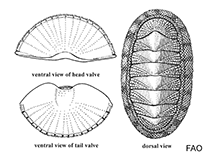Chiton tuberculatus Linnaeus, 1758
West Indian green chitonWarning: DOMDocument::load(): SSL operation failed with code 1. OpenSSL Error messages: error:140770FC:SSL routines:SSL23_GET_SERVER_HELLO:unknown protocol in C:\Apache24\htdocs\includes\SpeciesSummary.lib.php on line 1236
Warning: DOMDocument::load(): Failed to enable crypto in C:\Apache24\htdocs\includes\SpeciesSummary.lib.php on line 1236
Warning: DOMDocument::load(https://sealifebase.nrm.se/webservice/AquaMaps/getAMap.php?genus=Chiton&species=tuberculatus): failed to open stream: operation failed in C:\Apache24\htdocs\includes\SpeciesSummary.lib.php on line 1236
Warning: DOMDocument::load(): I/O warning : failed to load external entity "https://sealifebase.nrm.se/webservice/AquaMaps/getAMap.php?genus=Chiton&species=tuberculatus" in C:\Apache24\htdocs\includes\SpeciesSummary.lib.php on line 1236
Загрузить свой Фото
Изображение на Google | No image available for this species;
drawing shows typical species in Chitonidae.
Изображение на Google | No image available for this species;
drawing shows typical species in Chitonidae.
Classification / Names Common names | Synonyms | CoL | ITIS | WoRMS
| Chitonida | Chitonidae
Environment: milieu / climate zone / depth range / distribution range экология
; пределы глубины 0 - 4 m (Ref. 2022). Tropical
распространение страны | регионы FAO | Ecosystems | места находок | интродукции
Western Central Atlantic: USA, Colombia, Bermuda, Mexico, Venezuela and the West Indies.
Length at first maturity / Size / Вес / Возраст
Maturity: Lm ? range ? - ? cm Max length : 7.6 cm TL самец/пол неопределен; (Ref. 281)
Краткое описание морфология
Valve color: Dull grayish green or greenish brown; Some valves, dark-brown arrow-shaped patch on the dorsal ridge. Lateral areas: Five irregular, radiating cords. Central areas: Smooth at the top and eight to nine strong, wavy, longitudinal ribs on the sides. Girdle color: Alternating zones of whitish, green or black. Scales: Appear to be slightly higher than broad (Ref. 281).
Epibiotic (Ref. 110502). Very common under rocks, in the zone between tides (Ref. 292); intertidal to shallow subtidal (Ref. 289); intertidal and spray zones of rocky shores (Ref. 2022).
Life cycle and mating behavior половая зрелость | размножение | нерест | икра | Fecundity | личинки
Members of the class Polyplacophora are mostly gonochoric. Life cycle: Eggs hatch into lecitotrophic planktonic trocophore larvae (no veliger stage) which later metamorphose and settle on the bottom as young adults.
Основная ссылка
ссылки | координатор | соавторы
Burghardt, G. and L. Burghardt. 2006. (Ref. 281)
Статус Красного Списка МСОП (Ref. 130435)
Статус СИТЕС (Ref. 108899)
Not Evaluated
CMS (Ref. 116361)
Not Evaluated
Угроза для людей
Использование человеком
| FishSource |
инструменты
дополнительная информация
Возраст/Размеры
рост
Зависимость между длиной и массой тела
Зависимость между длинами
морфология
личинки
численность
рост
Зависимость между длиной и массой тела
Зависимость между длинами
морфология
личинки
численность
ресурсы в Интернет
BHL | BOLD Systems | CISTI | DiscoverLife | FAO(Publication : search) | Fishipedia | GenBank (Геном, Нуклеотид) | GloBI | Gomexsi | Google Books | Google Scholar | Google | PubMed | Tree of Life | Wikipedia (Вперёд, поиск) | Zoological Record
Estimates based on models
Preferred temperature
(Ref. 115969): 25.8 - 28.3, mean 27.5 (based on 436 cells).
Категория цены
(Ref. 80766):
Unknown.



